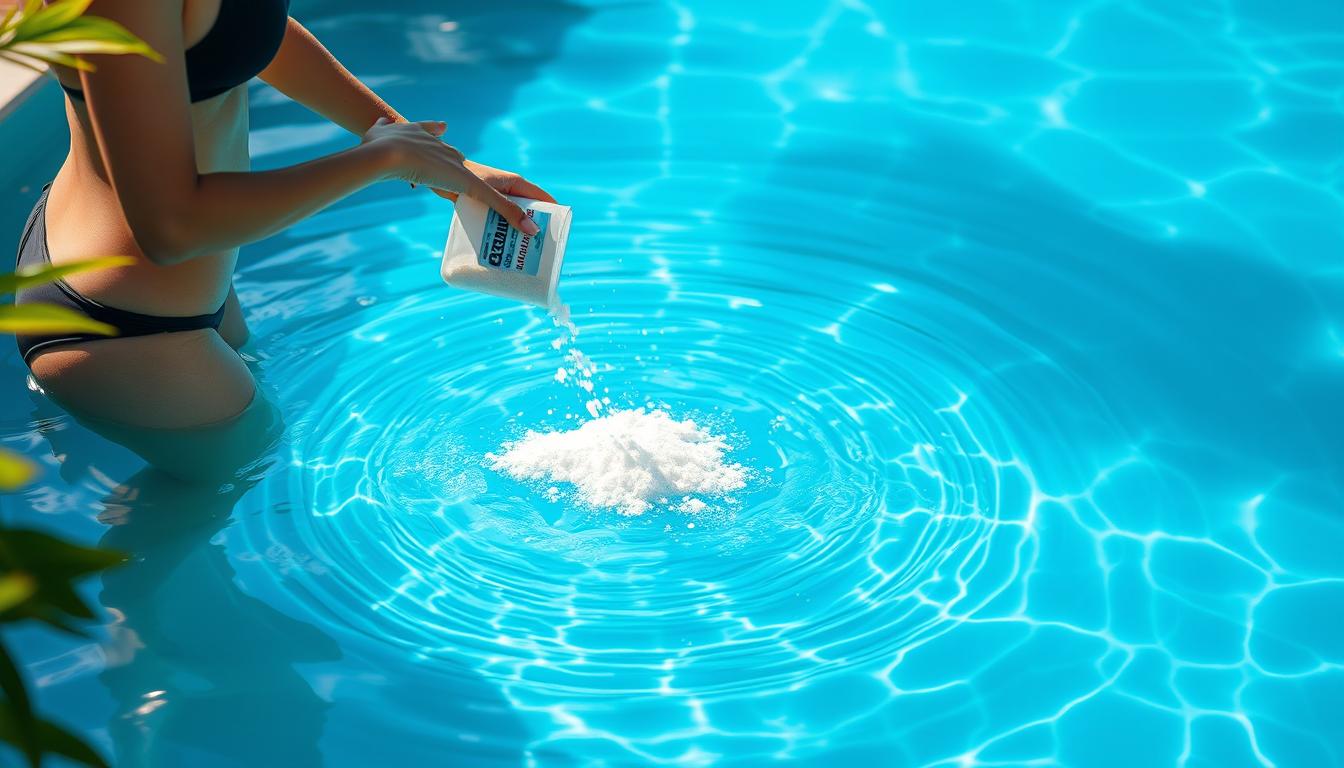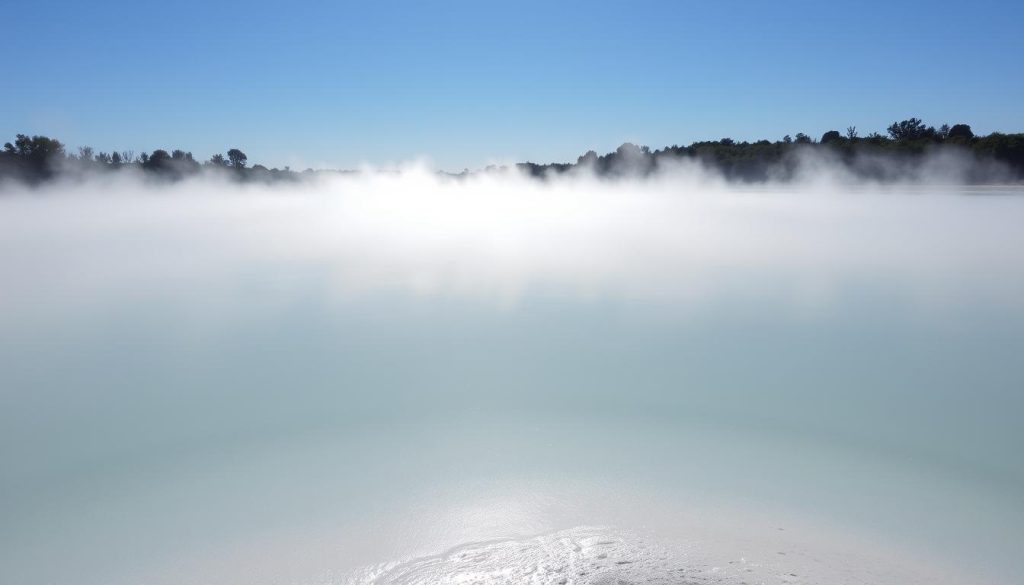
Picture a perfect pool day: sun shining, cool breeze, and crystal-clear water. But how do we keep salt water pools clean and inviting? Let’s explore whether shocking is necessary for these pools.
Shocking a pool means boosting chlorine or other chemicals temporarily. This cleans the water and fights contaminants like algae and bacteria. Salt water pools need less upkeep than traditional ones, but still require periodic shocking.
In this guide, we’ll explore salt pool system shocking and saltwater chlorinator maintenance. We’ll also cover best practices for a healthy swimming environment.
Understanding Salt Water Pool Maintenance
Salt water pools need a different approach than chlorine pools. They offer unique benefits and maintenance requirements. Let’s explore how to keep your salt water pool clean and enjoyable.
Salt Water vs. Chlorine Pools: Key Differences and Benefits
Salt water pools use a generator to make chlorine from salt. This process creates smoother water that’s gentler on skin and eyes. Chlorine pools need manual chlorine addition.
Salt water pools have less chlorine smell. They also need fewer added chemicals. These pools are more cost-effective over time.
- Lower chlorine odors
- Reduced need for added chemicals
- Gentler on skin and eyes
- More cost-effective in the long run
How Salt Water Generators Work
Salt water generators are crucial for pool maintenance. They use electrolysis to turn salt into chlorine. This process sanitizes the pool water.
Keep salt levels between 2,700 to 3,400 parts per million (ppm). Clean the salt cell every three months for best results.
The chlorine in saltwater pools is generated through a process called electrolysis, which converts salt into chlorine.
Benefits of Salt Water Pool Maintenance
Proper salt water pool care offers many advantages. It simplifies chemical management and reduces chlorine smells. The water feels gentler on swimmers’ skin.
- Simplified chemical management
- Reduced chlorine odors
- Gentler water for swimmers
- Lower ongoing maintenance costs
Maintain correct salt levels and clean the salt cell regularly. This ensures a clean, safe, and comfortable swimming environment.
| Parameter | Ideal Range |
|---|---|
| Salt Levels | 2,700 to 3,400 ppm |
| Free Chlorine | 1-3 ppm |
| pH | 7.2 to 7.8 |
| Cyanuric Acid | 30-50 ppm |
| Total Alkalinity | 80-120 ppm |
| Calcium Hardness | 200-400 ppm |
Regular testing of pH, Free Chlorine, Total Chlorine, Alkalinity, and Calcium Hardness is recommended each week to ensure water balance in a saltwater pool.
The Importance of Shocking a Salt Water Pool
Salt water pools need regular upkeep to stay clean and safe. Shocking the pool is a key part of this maintenance. It fights algae, bacteria, and chloramines, keeping your pool sparkling all season.
Combating Algae Growth and Bacteria
Algae and bacteria can make pool water green or cloudy. They can also pose health risks for swimmers. Cyanobacteria can create toxic blooms that irritate skin and eyes.
Bacteria from people, animals, or the environment can cause infections. Regular shocking eliminates these contaminants. This keeps your pool water clean and safe for swimming.

Reducing Chloramines and Improving Water Clarity
Chloramines form when chlorine mixes with sweat or other bodily fluids. They’re less effective at cleaning than free chlorine. They can also irritate eyes, skin, and lungs.
Over time, combined chlorine levels can build up. This reduces water quality and clarity. Shocking breaks down chloramines and restores free chlorine balance.
| Contaminant | Effects on Pool Water | Shocking Benefits |
|---|---|---|
| Algae (especially cyanobacteria) | Green or cloudy water, toxic blooms, skin and eye irritation | Eliminates algae, restores water clarity and safety |
| Bacteria | Potential health risks, infections, and illnesses | Kills bacteria, maintains hygienic swimming conditions |
| Chloramines (combined chlorine) | Less effective disinfectant, eye and skin irritation, reduced water clarity | Breaks down chloramines, restores free chlorine balance, improves water quality |
Regular shocking keeps your salt water pool clean and safe. It fights algae, bacteria, and chloramines effectively. Make shocking part of your pool care routine for the best results.
Do You Need to Shock a Salt Water Pool?
Salt water pools need regular shocking to maintain water quality and safety. Shocking helps eliminate contaminants, prevent algae growth, and ensure crystal-clear water. It’s an essential part of pool upkeep.
Several options are available for shocking a saltwater pool. These include liquid chlorine, calcium hypochlorite, lithium hypochlorite, sodium dichlor, and non-chlorine shock. Each type has its own pros and cons.
Chlorine-based shocks, like liquid chlorine and cal hypo, effectively kill algae and bacteria. They eliminate organic matter and restore chlorine levels. Non-chlorine shock reduces chloramines and improves water clarity without chlorine’s disinfecting properties.
It is recommended to shock the pool every week if it gets a lot of use, and around every two weeks if the pool is not used daily.
Shocking frequency depends on pool use, weather conditions, and contaminant presence. Experts suggest adding one pound of shock per 10,000 gallons of water. This amount may need adjustment based on water conditions.
| Pool Grade | Chlorine Level (ppm) |
|---|---|
| Excellent | 6 |
| Good | 12 |
| Fair | 30 |
| Poor | 60 |
Maintaining proper salt levels is crucial for salt water generator function. The ideal range is 2,700 to 3,400 parts per million (PPM). Regular testing of pH, chlorine, alkalinity, and calcium hardness ensures proper water balance.
Regular shocking and maintenance practices keep your salt water pool clean and safe. This ensures an inviting swimming environment throughout the season.
Best Practices for Shocking Your Salt Water Pool
Start by testing your pool water. Ensure pH levels are 7.4-7.6 and alkalinity is 100-150 ppm. Wear gloves and goggles when handling chlorine-based shock treatments. Calculate the right amount of shock based on your pool size.
If using calcium hypochlorite, predissolve it before adding. Run your pool pump continuously during shocking. Pour the shock evenly around the pool, avoiding splashback.
Let the pump run for 6-8 hours after shocking. Retest the water before swimming. Confirm chlorine levels are 1.0-3.0 ppm.
Shock your pool in the evening for best results. Don’t mix different shock treatments. Shock every 1-2 weeks during swim season.
Regular testing and proper shocking maintain a clean pool. Your family can enjoy a healthy, inviting salt water pool. Follow these practices for the best swimming experience.







